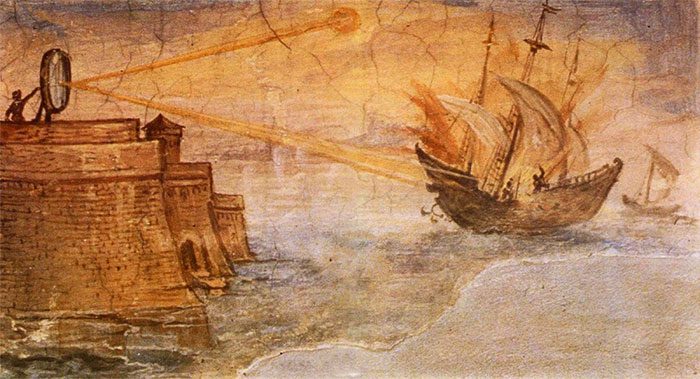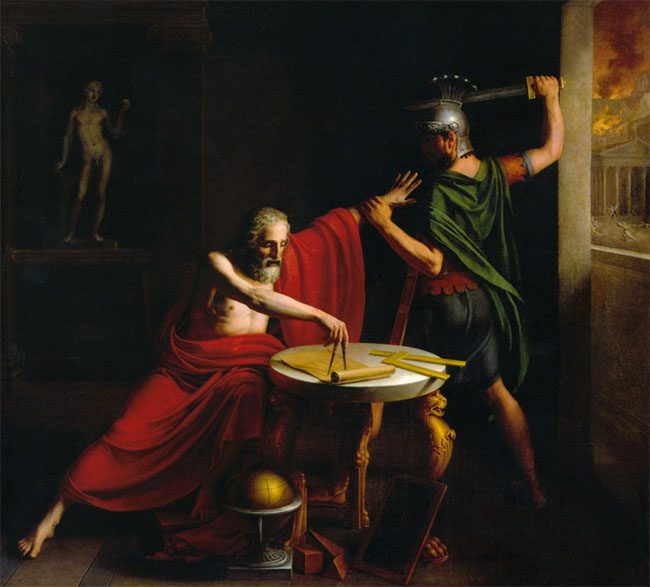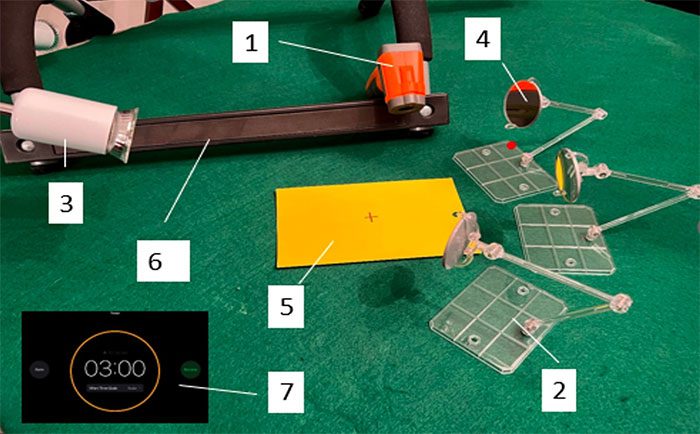We have finally learned how the “Death Ray,” also known as the thermal ray, operates.
An eighth-grade student from Ontario, Canada, has contributed to resolving a long-standing historical dispute by demonstrating the hidden functionality of the “Death Ray” attributed to the ancient Greek scholar Archimedes.

A wall painting from 1600 depicts the Death Ray, an invention of the Greek mathematician Archimedes, used to ignite Roman military ships during the Siege of Syracuse.
Archimedes was a Greek mathematician and inventor who lived in the 3rd century BC. He is renowned for his discoveries in geometry, physics, and engineering, and is often regarded as the greatest mathematician of ancient history and one of the greatest of all time. According to various historical accounts, he used his talents to defend his hometown of Syracuse in Sicily from a Roman siege by designing various war machines, including a thermal ray capable of igniting wooden ships from a distance.
The thermal ray consists of a series of reflective mirrors that concentrate sunlight onto a single point, generating intense heat and fire. However, the existence and effectiveness of this device have been debated for centuries, as there is no direct evidence of it in Archimedes’ surviving works.
In 1973, Greek scientist Ioannis Sakkas conducted an experiment on Archimedes’ thermal ray at the Skaramagas naval base near Athens. Greek sailors held 70 bronze mirrors, each approximately 5 x 3 feet (1.5 x 1 m), aimed at a model of a Roman warship located about 160 feet (50 m) away. When the mirrors were properly aligned, the ship ignited within seconds due to its tar-coated surface. Sakkas concluded definitively that Archimedes could have used bronze mirrors to destroy Roman ships.
Several modern experiments have attempted to test the feasibility of the thermal ray, yielding varying results.
In 2008, the television program “Richard Hammond’s Tech Connection” showcased the Keck Observatory, which features a telescope inspired by Archimedes’ mirrors. The demonstration successfully used a smaller curved mirror to ignite a wooden model.

Archimedes died after his city, Syracuse, was captured by the Romans, suffering significant losses due to his inventions. According to the most popular stories, while studying a mathematical diagram during the siege, Archimedes refused to meet the Roman commander Marcellus when summoned by a Roman soldier. Archimedes’ refusal enraged the soldier, who killed him with his sword.
In 2004, the television show MythBusters found the use of mirrors as weapons to be implausible in their episode “The Ancient Death Ray.” The following year, an MIT student tested the idea using 127 one-foot (30 cm) mirrors on a wooden ship from a distance of about 100 feet (30 m). Flames eventually appeared, but only under ideal weather conditions (clear skies) and after a considerable amount of time (about 10 minutes).
MythBusters later repeated this experiment in San Francisco, confirming that flames could appear but, due to the time and weather requirements, more conventional weapons like flaming arrows or catapults would be significantly more effective at igniting a ship at close range.
In 2010, MythBusters revisited the idea, involving 500 students and a larger model sailboat located 400 feet (120 m) away. Despite extensive testing, the sail did not reach the necessary temperature to ignite, leading to the conclusion that the mirrors were more likely to cause blindness or distraction than to set a ship on fire.
Brenden Sener, 12 years old, was fascinated by the mystery of the Death Ray and decided to recreate the mechanism himself. He spent several weeks researching, designing, and constructing his version of the thermal ray using materials such as cardboard, mirrors, and lights, along with an infrared thermometer to measure the temperature of the focal point.

Materials used for the experiment: Infrared thermometer; Clips; Heating lamps (50W, 100W); Concave mirrors (four); Target paper; Thermometer stand; 3-minute timer.
Sener discovered that when using reflective mirrors to focus a 50-watt heat source onto a piece of cardboard, the temperature of the target increased by 2°C (3.6°F) for each additional mirror—up to a maximum of three mirrors. However, adding a fourth mirror significantly increased the temperature by up to 8°C (14.4°F).
When repeating the experiment with a 100-watt bulb, he observed that “the temperature change for each mirror was 4°C for 3 mirrors and an additional 10°C with the fourth mirror.”
The young researcher wrote: “Based on my experimental findings, I agree with the MIT group and believe that with a sufficiently strong heat source and with more mirrors focused at a perfect angle, combustion could occur.
His final assessment was: “The historical descriptions of the use of the Death Ray in ancient Syracuse are reasonable; however, there is no archaeological evidence of Archimedes’ Death Ray found beyond what is recorded in the writings of ancient philosophers.”

12-year-old research author, Brenden Sener.
To recognize his efforts, Sener was awarded the Gold Medal at the Annual Matthews Hall Science Fair, the Gold Medal at the Thames Valley Science and Engineering Fair for Physical Science, and the London Public Library Award for Inspiring Children’s Interest in Science and Technology.


















































